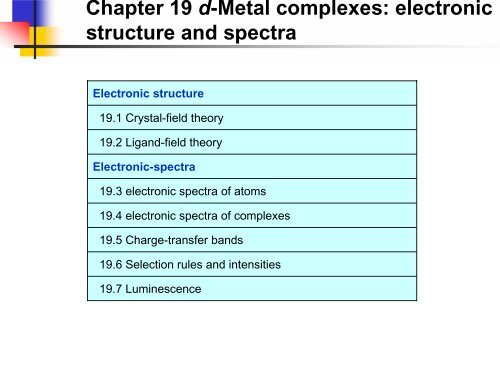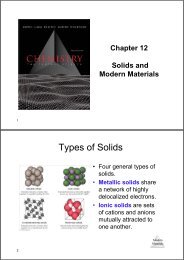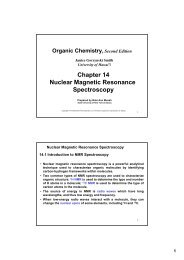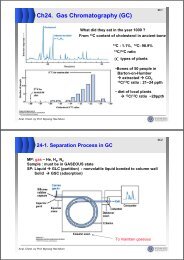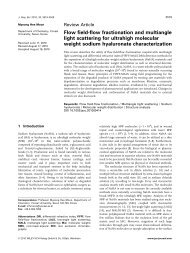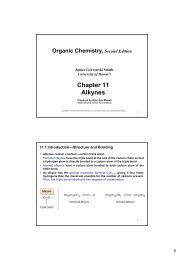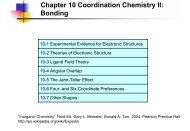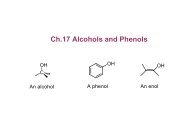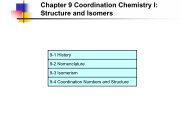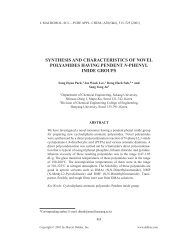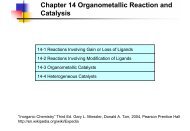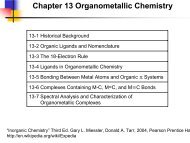Chapter 19 d-Metal complexes: electronic structure and spectra
Chapter 19 d-Metal complexes: electronic structure and spectra
Chapter 19 d-Metal complexes: electronic structure and spectra
Create successful ePaper yourself
Turn your PDF publications into a flip-book with our unique Google optimized e-Paper software.
<strong>Chapter</strong> <strong>19</strong> d-<strong>Metal</strong> <strong>complexes</strong>: <strong>electronic</strong><br />
<strong>structure</strong> <strong>and</strong> <strong>spectra</strong><br />
Electronic <strong>structure</strong><br />
<strong>19</strong>.1 Crystal-field theory<br />
<strong>19</strong>.2 Lig<strong>and</strong>-field theory<br />
Electronic-<strong>spectra</strong><br />
<strong>19</strong>.3 <strong>electronic</strong> <strong>spectra</strong> of atoms<br />
<strong>19</strong>.4 <strong>electronic</strong> <strong>spectra</strong> of <strong>complexes</strong><br />
<strong>19</strong>.5 Charge-transfer b<strong>and</strong>s<br />
<strong>19</strong>.6 Selection rules <strong>and</strong> intensities<br />
<strong>19</strong>.7 Luminescence
<strong>Chapter</strong> 10 Coordination Chemistry II:<br />
Bonding<br />
10-1 Experimental Evidence for Electronic Structures<br />
10-2 Theories of Electronic Structure<br />
10-3 Lig<strong>and</strong> Field Theory<br />
10-4 Angular Overlap<br />
10-5 The Jahn-Teller Effect<br />
10-6 Four- <strong>and</strong> Six-Coordinate Preferences<br />
10-7 Other Shapes<br />
“Inorganic Chemistry” Third Ed. Gary L. Miessler, Donald A. Tarr, 2004, Pearson<br />
Prentice Hall<br />
http://en.wikipedia.org/wiki/Expedia
Experimental Evidence for Electronic Structures<br />
Thermodynamic Data<br />
Magnetic Susceptibility<br />
Electronic Spectra<br />
Coordination Numbers <strong>and</strong> Molecular<br />
Shapes
Experimental Evidence for Electronic Structures;<br />
Thermodynamic Data<br />
One of the primary goal of a bonding theory is to<br />
explain the energy of compound.<br />
The energy is openly not determined directly by<br />
experiment.<br />
Thermodynamic measurements of enthalpies <strong>and</strong><br />
free energies of reaction are used to compare.<br />
Bonding strength Stability constants(formation constants)
Experimental Evidence for Electronic Structures;<br />
Thermodynamic Data<br />
What is the stability constants<br />
The equilibrium constants for formation of<br />
coordination complex.
Experimental Evidence for Electronic Structures;<br />
Thermodynamic Data<br />
Stability constants<br />
HSAB concepts<br />
Thermodynamic values <br />
Prediction of properties, <strong>structure</strong>s
Experimental Evidence for Electronic Structures;<br />
Thermodynamic Data<br />
HSAB concepts<br />
The gist of this theory is that soft acids react faster <strong>and</strong> form<br />
stronger bonds with soft bases, whereas hard acids react<br />
faster <strong>and</strong> form stronger bonds with hard bases, all other factors<br />
being equal.<br />
The classification in the original work was mostly based on<br />
equilibrium constants for reaction of two Lewis bases competing<br />
for a Lewis acid.<br />
Hard acids <strong>and</strong> hard bases tend to have:<br />
small size<br />
high oxidation state<br />
low polarizability<br />
high electronegativity<br />
energy low-lying HOMO (bases) or energy high-lying LUMO<br />
(acids).
Experimental Evidence for Electronic Structures;<br />
Thermodynamic Data<br />
HSAB concepts
Experimental Evidence for Electronic Structures;<br />
Thermodynamic Data<br />
Chelating Lig<strong>and</strong>s<br />
Entropy Effect<br />
Chelate Effect<br />
Five or six membered ring<br />
en vs methyl amine<br />
Figure in head….<br />
Stability….
Experimental Evidence for Electronic Structures;<br />
Magnetic Susceptibility<br />
The magnetic properties of a coordination<br />
compound can provide indirect evidence of the<br />
orbital energy level.<br />
Hund’s rule the max. # of unpaired e - .<br />
Diamagnetic: all e - paried repelled by a magnetic field<br />
Paramagnetic: all e - paried attracted into a magnetic field<br />
Magnetic Susceptibility: Measuring Magnetism
Experimental Evidence for Electronic Structures;<br />
Magnetic Susceptibility<br />
Magnetic Susceptibility<br />
Gouy method<br />
A sample that is to be tested is suspended<br />
from a balance between the poles of a<br />
magnet. The balance measures the<br />
apparent change in the mass of the<br />
sample as it is repelled or attracted by the<br />
magnetic field.
Experimental Evidence for Electronic Structures;<br />
Magnetic Susceptibility<br />
In physics <strong>and</strong> applied disciplines such as electrical<br />
engineering, the magnetic susceptibility is the degree of<br />
magnetization of a material in response to an applied<br />
magnetic field.<br />
Electron spin Spin magnetic moment (m s )<br />
Total spin magnetic moment Spin quantum # S (sum of m s )<br />
Isolated oxygen atom 1s 2 2s 2 p 4<br />
S = +1/2 +1/2 +1/2 -1/2 = 1<br />
Electron spin Orbital magnetic moment (m l )<br />
Total orbital magnetic moment Orbital quantum # L (sum of m l )<br />
Max. L for the p 4<br />
L = +1 +0 -1 +1 = 1
Experimental Evidence for Electronic Structures;<br />
Magnetic Susceptibility<br />
Two sources of magnetic moment – spin (S) <strong>and</strong> Angular (L) motions of electrons<br />
Spin quantum number<br />
Angular momentum quantum number<br />
The equation for the magnetic moment<br />
Contribution from L is small in first transition series<br />
2.00023 ≈ 2
Experimental Evidence for Electronic Structures;<br />
Electronic Spectra<br />
Give a direct evidence of orbital energy level<br />
Give an information for geometry of <strong>complexes</strong>
Theories of Electronic Structure<br />
Valence bond theory<br />
Crystal field theory<br />
Lig<strong>and</strong> field theory<br />
Angular overlap method
Theories of Electronic Structure;<br />
Valence bond theory<br />
Hybridization ideas<br />
Octahedral: d 2 sp 3<br />
d orbitals could be 3d or 4d for the first-row<br />
transition metals. (hyperligated, hypoligated)
Theories of Electronic Structure;<br />
Valence bond theory<br />
Fe(III)<br />
Isolated ion; 5 unpaired e -<br />
In O h compound; 1 or 5 unpaired e -<br />
Co(II)<br />
Low spin<br />
Low spin<br />
High spin<br />
High spin
Theories of Electronic Structure;<br />
Crystal field theory<br />
Crystal field theory (CFT) is a model that describes the<br />
<strong>electronic</strong> <strong>structure</strong> of transition metal compounds, all of<br />
which can be considered coordination <strong>complexes</strong>.<br />
CFT successfully accounts for some magnetic properties,<br />
colours, hydration enthalpies, <strong>and</strong> spinel <strong>structure</strong>s of<br />
transition metal <strong>complexes</strong>, but it does not attempt to<br />
describe bonding.<br />
CFT was developed by physicists Hans Bethe <strong>and</strong> John<br />
Hasbrouck van Vleck in the <strong>19</strong>30s.<br />
CFT was subsequently combined with molecular orbital<br />
theory to form the more realistic <strong>and</strong> complex lig<strong>and</strong> field<br />
theory (LFT), which delivers insight into the process of<br />
chemical bonding in transition metal <strong>complexes</strong>.
Theories of Electronic Structure;<br />
Crystal field theory<br />
Repulsion between d-orbital electrons <strong>and</strong> lig<strong>and</strong> electrons<br />
Splitting of energy levels of d-orbitals
Theories of Electronic Structure;<br />
Crystal field theory
Theories of Electronic Structure;<br />
Crystal field theory
Theories of Electronic Structure;<br />
Crystal field theory<br />
Electrostatic approach<br />
In an Octahedral field of lig<strong>and</strong> e - pairs; any e -<br />
in them are repelled by the field.<br />
Crystal field stabilization energy (CFSE);<br />
the actual distribution vs the uniform field.<br />
Good for the concept of the repulsion of<br />
orbitals by the lig<strong>and</strong>s but no explanation<br />
for bonding in coordination <strong>complexes</strong>.
Theories of Electronic Structure;<br />
Crystal field theory
Theories of Electronic Structure;<br />
Crystal field theory
Theories of Electronic Structure;<br />
Crystal field theory
Theories of Electronic Structure;<br />
Crystal field theory
Theories of Electronic Structure;<br />
Crystal field theory
Theories of Electronic Structure;<br />
Crystal field theory
Theories of Electronic Structure;<br />
Crystal field theory<br />
Why are <strong>complexes</strong> formed in crystal field theory<br />
Crystal Field Stabilization Energy (CFSE)<br />
Or Lig<strong>and</strong> Field Stabilization Energy (LFSE)<br />
the stabilization of the d orbitals because of<br />
metal-lig<strong>and</strong> environments
Theories of Electronic Structure;<br />
Crystal field theory<br />
∆E = strong field – weak field<br />
∆E > 0 weak field<br />
∆E < 0 strong field
Theories of Electronic Structure;<br />
Crystal field theory<br />
What determine <br />
Depends on the relative energies<br />
of the metal ions <strong>and</strong> lig<strong>and</strong><br />
orbitals <strong>and</strong> on the degree of<br />
overlap.
Theories of Electronic Structure;<br />
Crystal field theory<br />
Spectrochemical Series for <strong>Metal</strong> Ions<br />
Oxidation # ∆<br />
Small size & higher charge<br />
Pt 4+ > Ir 3+ > Pd 4+ > Ru 3+ > Rh 3+ >Mo 3+ ><br />
Mn 4+ > Co 3+ > Fe 3+ > V 2+ > Fe 2+<br />
Co 2+ > Ni 2+ > Mn 2+<br />
Only low spin aqua complex
Lig<strong>and</strong> field theory;<br />
Molecular orbitals for Octahedral <strong>complexes</strong><br />
CFT & MO were combined<br />
The d x2-y2 <strong>and</strong> d z2 orbitals can form bonding orbitals<br />
with the lig<strong>and</strong> orbitals, but d xy , d xz , <strong>and</strong> d yz orbitals<br />
cannot form bonding orbitals
Lig<strong>and</strong> field theory;<br />
Molecular orbitals for Octahedral <strong>complexes</strong><br />
The combination of<br />
the lig<strong>and</strong> <strong>and</strong> metal<br />
orbitals (4s, 4p x , 4p y ,<br />
4p z , 3d z2 , <strong>and</strong> 3d x2-y2 )<br />
form six bonding <strong>and</strong><br />
six antibonding with<br />
a 1g , e g , t 1u symmetries.<br />
The metal T 2g orbitals<br />
do Electron not have in bonding<br />
appropriate orbitals provide symmetry the<br />
- nonbonding<br />
potential energy that holds<br />
molecules together
Lig<strong>and</strong> field theory;<br />
Orbital Splitting <strong>and</strong> Electron Spin<br />
Strong-field lig<strong>and</strong> – Lig<strong>and</strong>s whose orbitals<br />
interact strongly with the metal orbitals <br />
large ∆ o<br />
Weak-field lig<strong>and</strong>.<br />
d 0 ~d 3 <strong>and</strong> d 8 ~d 10 – only one electron<br />
configuration possible no difference in the<br />
net spin<br />
Strong fields lead to low-spin <strong>complexes</strong><br />
Weak fields lead to high-spin <strong>complexes</strong>
Lig<strong>and</strong> field theory;<br />
Orbital Splitting <strong>and</strong> Electron Spin<br />
What determine <br />
Depends on the relative<br />
energies of the metal ions<br />
<strong>and</strong> lig<strong>and</strong> orbitals <strong>and</strong> on<br />
the degree of overlap.
Lig<strong>and</strong> field theory;<br />
Orbital Splitting <strong>and</strong> Electron Spin<br />
Spectrochemical Series for <strong>Metal</strong> Ions<br />
Oxidation # ∆<br />
Small size & higher charge<br />
Pt 4+ > Ir 3+ > Pd 4+ > Ru 3+ > Rh 3+ >Mo 3+ ><br />
Mn 4+ > Co 3+ > Fe 3+ > V 2+ > Fe 2+<br />
Co 2+ > Ni 2+ > Mn 2+
Lig<strong>and</strong> field theory;<br />
Lig<strong>and</strong> field Stabilization Energy
Lig<strong>and</strong> field theory;<br />
Orbital Splitting <strong>and</strong> Electron Spin<br />
Orbital configuration of the complex is<br />
determined by ∆ o , c , <strong>and</strong> e<br />
In general ∆ o for 3 + ions is larger than ∆ o for 2 + ions<br />
with the same # of e - .<br />
∆ o > low-spin<br />
∆ o < high-spin<br />
For low-spin<br />
configuration<br />
Require a strong<br />
field lig<strong>and</strong>
Lig<strong>and</strong> field theory;<br />
Lig<strong>and</strong> field Stabilization Energy
Lig<strong>and</strong> field theory;<br />
Orbital Splitting <strong>and</strong> Electron Spin<br />
The position of the metal in the periodic<br />
table<br />
Second <strong>and</strong> third transition series form lowspin<br />
more easily than metals form the first<br />
transition series<br />
-The greater overlap between the larger 4d<br />
<strong>and</strong> 5d orbitals <strong>and</strong> the lig<strong>and</strong> orbitals<br />
-A decreased pairing energy due to the<br />
larger volume available for electrons
Lig<strong>and</strong> field theory;<br />
Pi-Bonding<br />
The reducible representation is
Lig<strong>and</strong> field theory;<br />
Pi-Bonding<br />
LUMO orbitals:can be used<br />
for bonding with metal<br />
HOMO
Lig<strong>and</strong> field theory;<br />
Pi-Bonding<br />
metal-to-lig<strong>and</strong> bonding<br />
or back-bonding<br />
-Increase stability<br />
-Low-spin configuration<br />
-Result of transfer of<br />
negative charge away from<br />
the metal ion<br />
Lig<strong>and</strong>-to metal bonding<br />
-decrease stability<br />
-high-spin configuration
Lig<strong>and</strong> field theory;<br />
Square planar Complexes; Sigma bonding
Lig<strong>and</strong> field theory;<br />
Square planar Complexes; Sigma bonding<br />
ll<br />
⊥<br />
16 e - e - from metal<br />
8 e -
Lig<strong>and</strong> field theory;<br />
Tetrahedral Complexes; Sigma bonding<br />
The reducible representation is<br />
A 1 <strong>and</strong> T 2
Lig<strong>and</strong> field theory;<br />
Tetrahedral Complexes; Pi bonding<br />
The reducible representation is<br />
E, T 1 <strong>and</strong> T 2
Angular Overlap<br />
LFT <br />
No explicit use of the energy change that results<br />
Difficult to use other than octahedral, square<br />
planar, tetrahedral.<br />
Deal with a variety of possible geometries <strong>and</strong><br />
with a mixture of lig<strong>and</strong>. Angular Overlap<br />
Model<br />
The strength of interaction between individual lig<strong>and</strong><br />
orbitals <strong>and</strong> metal d orbitals based on the overlap<br />
between them.
Angular Overlap:<br />
Sigma-Donor Interactions<br />
The strongest interaction<br />
There are no examples of <strong>complexes</strong> with e - in<br />
the antibonding orbitals from s <strong>and</strong> p orbitals,<br />
<strong>and</strong> these high-energy antibonding orbitals are<br />
not significant in describing the <strong>spectra</strong> of<br />
<strong>complexes</strong>. we will not consider them further.
Angular Overlap:<br />
Sigma-Donor Interactions
Angular Overlap:<br />
Sigma-Donor Interactions<br />
Stabilization is 12e
Angular Overlap:<br />
Pi-Acceptor Interactions<br />
The strongest interaction is considered to<br />
be between a metal d xy orbitals <strong>and</strong> a lig<strong>and</strong> *<br />
orbital.<br />
Because of the overlap for these orbitals is<br />
smaller than the overlap, e < e .
Angular Overlap:<br />
Pi-Acceptor Interactions
Angular Overlap:<br />
Pi-Acceptor Interactions
Angular Overlap:<br />
Pi-Donor Interactions<br />
In general, in situations involving lig<strong>and</strong>s that can<br />
behave as both acceptors <strong>and</strong> donors (such<br />
as CO, CN - ), the acceptor nature predominates.
Angular Overlap:<br />
Pi-Donor Interactions
Angular Overlap:<br />
Pi-Acceptor Interactions
Angular Overlap:<br />
Types of the lig<strong>and</strong>s <strong>and</strong> the spectrochemical series<br />
Spectrochemical Series for Lig<strong>and</strong>s<br />
CO > CN - > PPh 3 > NO 2- > phen > bipy > en<br />
NH 3 > py > CH 3 CN > NCS - > H 2 O > C 2 O 4<br />
2-<br />
OH - > RCO 2- > F - > N 3- > NO 3- > Cl - > SCN -<br />
S 2- > Br - > I -<br />
donor only<br />
acceptor (strong field lig<strong>and</strong>)<br />
donor(weak field lig<strong>and</strong>)
Angular Overlap:<br />
Magnitudes of e e<strong>and</strong> ∆<br />
<strong>Metal</strong> <strong>and</strong> lig<strong>and</strong>
Angular Overlap:<br />
Magnitudes of e e<strong>and</strong> ∆<br />
Angular overlap<br />
parameters derived<br />
from <strong>electronic</strong><br />
<strong>spectra</strong><br />
e is always larger<br />
than e . overlap<br />
iso<strong>electronic</strong><br />
The magnitudes of<br />
both the <strong>and</strong> <br />
parameters with<br />
size <strong>and</strong> <br />
electronegativity of<br />
the halide ions.<br />
overlap
Angular Overlap:<br />
Magnitudes of e e<strong>and</strong> ∆<br />
Can describe the<br />
<strong>electronic</strong> energy<br />
of <strong>complexes</strong> with<br />
different shapes or<br />
with combinations<br />
of different liagnds.<br />
The magnitude of<br />
∆ o Magnetic<br />
properties <strong>and</strong><br />
visible spectrum.
Angular Overlap:<br />
The Jahn-Teller Effect<br />
There cannot be unequal occupation of orbitals with identical orbitals.<br />
To avoid such unequal occupation, the molecule distorts so that<br />
these orbitals no longer degenerate.<br />
In other words, if the ground electron configuration of a nonlinear<br />
complex is orbitally degenerate, the complex will distort to remove<br />
the degeneracy <strong>and</strong> achieve a lower energy.
Angular Overlap:<br />
The Jahn-Teller Effect
Angular Overlap:<br />
Four- <strong>and</strong> Six-Coordinate Preference<br />
Only bonding is considered.<br />
Angular overlap calculations<br />
Low-spin square planar<br />
Large # of bonds formed in<br />
the octahedral <strong>complexes</strong>.
Angular Overlap:<br />
Four- <strong>and</strong> Six-Coordinate Preference
Angular Overlap:<br />
Four- <strong>and</strong> Six-Coordinate Preference<br />
How accurate are these predictions<br />
Their success is variable, because of there are other differences<br />
between metals <strong>and</strong> between lig<strong>and</strong>s.<br />
In addition, bond lengths for the same lig<strong>and</strong>-metal pair depend on<br />
the geometry of the complex.<br />
The interactions of the s <strong>and</strong> p orbitals.<br />
The formation enthalpy for <strong>complexes</strong> also becomes more negative<br />
with increasing atomic number <strong>and</strong> increasing ionization energy.<br />
By careful selection of lig<strong>and</strong>s, many of the transition metal ions can<br />
form compounds with geometries other than octahedral.
Angular Overlap:<br />
Other shapes<br />
1<br />
1<br />
1<br />
Strength of –interaction<br />
1<br />
1<br />
2+3/4 9/8 9/8 0 0
Angular Overlap:<br />
Other shapes<br />
Trigonal-bipyramidal ML 5 (D 3h ) -donor only
Homework<br />
Exercise 10-1~10-11<br />
Problem 2, 6a, 6c,11, 13, 16.


